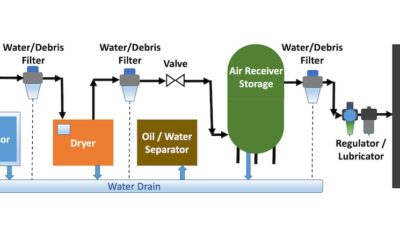Diesel and Gasoline Alternative Gains Popularity in North America

Powered by persistently high diesel and gasoline fuel prices, and encouraged by state and federal incentive programs for alternate fuel vehicles, the use of natural gas as a trucking fuel continues to find converts in the U.S. and Canada. Many of the applications are on vehicles that are used during the day and returned to a base station at night, making refueling easier. Both public and private refueling stations are becoming more abundant.
Fueling Stations Critical Components
One of the leading industry organizations supporting natural gas fueling is the Natural Gas Vehicle Institute (NGVi). This organization offers guidance and training for fleet operators who are contemplating converting to or expanding natural gas-powered fleet vehicles. NGVi CEO Leo Thomason was a recent presenter on a panel discussion on natural gas vehicles at a Technology Market Assessment Forum sponsored by the Energy Solutions Center. In his presentation, Thomason stressed the key role played by fueling stations for commercial and industrial natural gas users.
He explained that there are four basic types of natural gas fuelling stations. The simplest is time-fill fueling, where a fleet of vehicles at a central garage can be filled during nighttime or other inactive hours. This is ideal for fleets of vehicles that are at a central location for 6-8 hours and can operate all day on a single fill. Examples are school buses, transit buses, delivery vans, refuse trucks and ready-mix cement vehicles.
Fast-Fill Stations for Random Fueling
The opposite is fast-fill, which is used for vehicles that need to be quickly refueled at random hours through the day. A third type is combination time-fill and fast-fill, which is suitable for a mix of vehicle types and for those that require refueling at random times. The fourth type is buffer fast-fill, used where large numbers of vehicles need to be refueled consecutively – for example, fleets of transit buses. A buffer tank allows quick consecutive refilling.
Thomason explains that the cost of the refueling station varies with the type of capability, and can range from several thousand dollars for a small timed-fill system for a single vehicle to several million dollars for a fleet refueling station for 200 transit buses. He notes that a public-access fast-fill station could run from $400,000 to $500,000. Owners need to consider this expense in evaluating the feasibility of going to a natural gas fleet. He indicates that there continues to be an active “buildout” of natural gas fueling infrastructure in North America.
Infrastructure Continues to Expand
The natural gas fueling infrastructure has been steadily expanding beyond California in recent years. According to Thomason, a good part of the expansion has come from the activities of Clean Energy of Seal Beach, California. This company is the largest retailer of natural gas as a transportation fuel in the U.S. Clean Energy has built and operates public-access CNG fueling stations in Arizona, Colorado, Nevada, New Mexico, New York, Texas, Wyoming, Oklahoma and Georgia.
Thomason adds that many natural gas utilities have and continue to operate public-access fueling stations within their areas. These include DTE Energy, Avista Utilities, Alabama Gas, Atlanta Gas Light, National Grid, Questar Utilities, Piedmont Natural Gas and others.
Manufacturer Credits Offset Engine Expense
According to Andy Douglas, National Sales Manager, Specialty Markets for Kenworth Truck Company, there continue to be price credits for owners who choose to operate CNG trucks. A CNG-powered refuse truck or cement truck would receive a $10,000 credit for not having the SCR after-exhaust treatment system required for a diesel-powered version of the same truck. This would offset the $10,000 premium for the Cummins-Westport CNG engine for the truck. According to Thomason, there continue to be new natural gas engine conversion companies entering the market. Currently there are five companies that manufacture EPA/CARB certified conversion systems for gasoline-powered vehicles in the U.S.
Rich Kolodziej is the President of NGVAmerica, an organization dedicated to the promotion of the use of natural gas vehicles in the U.S. He points out that earlier arguments that the U.S. lacked a sufficient long-term supply of natural gas have been demolished. He states, “Technological advances such as deep drilling, horizontal drilling and fracturing have made previous uneconomic gas play (like shale gas) quite economic. This has in turn resulted in estimates of economically recoverable gas at (or over) 100 years.”
Current NGV Legislation Important
Kolodziej stresses the importance of legislation such as the currently pending NAT GAS Act (HR 1380) currently under consideration in the House of Representatives. A companion Senate bill will be introduced this summer. The bill would provide a number of financial incentives to fleets and consumers who buy natural gas vehicles, and to fueling station operators who install natural gas fueling equipment. He is hopeful the legislation will be signed into law in 2011 and will continue and enhance previous federal incentive programs.
Kolodziej also points out that there is incredible activity at the state level promoting NGVs. Currently 255 bills are under consideration in state legislatures that would provide a variety of incentives or supports for NGV activity. Kolodziej notes, “Because of its special environmental problems and concerns, Utah has been in the vanguard of providing incentives for and otherwise promoting NGVs. But the rest of the country is catching up fast. Utah has been a strong NGV promoter for a number of years and Oklahoma, Louisiana and Texas have recently enacted or expanded incentives for NGVs.”
Fuel Price Advantage Continues
Since 2005 the energy market has shown significant price spreads between the delivered fuel cost of diesel fuel and natural gas. Natural gas at $6/mmBtu is approximately equivalent to crude oil at $45/barrel, a price we haven’t enjoyed for a long time.
According to recent studies, the next three to five years may show increasing price spreads as a result of strong domestic production of natural gas from conventional and shale gas sources, and continuing upward pressure on petroleum prices because of global oil demand and geopolitical uncertainty. At the current time, up to 98% of the natural gas used in the U.S. and Canada is from U.S. and Canadian sources. This gives additional security for fleet fuel supplies.
Things Lining Up Favorably
The future looks bright for the NGV industry. Rich Kolodziej says, “NGVs have always had public policy benefits. Now that we have the natural gas supply, we have the vehicles, we have public policy support and we have the economics.” He notes that the number of NGVs worldwide has grown from 3.8 million in 2003 to 13.2 million today. While many of those are light-duty vehicles in Pakistan, India and Iran, the growth in North America has been largely heavy-duty trucks and buses. This truly is a growth industry, and one that promises rewards for early adaptors. Now may be your time to take advantage of this trend.
More Info. >>>
Doe Natural Gas Vehicle Information
www.afdc.energy.gov/afdc/vehicles/natural_gas.html
Energy Solutions Center NGV Workgroup
www.energysolutionscenter.org/consortia/ngv_workgroup.aspx
Natural Gas Vehicles for America (NGVAmerica)
www.ngvc.org
Natural Gas Vehicle Institute (NGVI)



